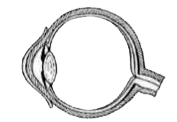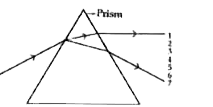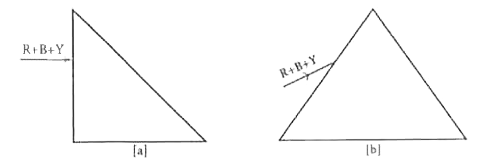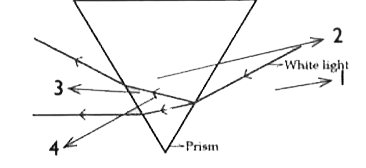Complete Solutions to ZEN ADDITIONAL QUESTIONS SECTION - SHORT ANSWER TYPE QUESTIONS - I of chapter THE HUMAN EYE AND THE COLOURFUL WORLD of Class 10 book with complete answers and questions
| Class 10 | PHYSICS |
| Chapter | THE HUMAN EYE AND THE COLOURFUL WORLD |
| ZEN PUBLICATION | ZEN ADDITIONAL QUESTIONS SECTION - SHORT ANSWER TYPE QUESTIONS - I |
| Number Of Questions | 66 |
| Academic Year | 2023-24 |
Name the four parts labelled as 1,2,3 and 4 in the given figure.
 View Solution
View SolutionIn a human eye, name the following parts.
(i) A thin membrane which allows light to enter into the eyes.
(ii) The muscles which help in changing the focal length of the eye lens.01:41View SolutionHow are we able to see nearby and also the distant objects clearly ?
01:49View SolutionWhat is meant by accomodation of the eye ?
View SolutionName the parts of the eye which help in this phenomena and state how they help.
View SolutionExplain the changes taking place in the cilary muscles when we focus on a nearby object and far-off objects.
View SolutionHow do the iris and pupil respond to (i) dim and (ii) bright light ?
View SolutionName the screen on which an image is formed in the eye. What is the range of vision of a normal human eye ?
02:08View SolutionHow can change of size of eyeball be one of the reason for (i) myopia and (ii) herpmetropia eye ? Compare the size eyeball with that of a normal eye in each case.
How does this change of size affect the position of image in each case ?View SolutionExplain giving reason the type of lens used to correct the defect of vision in myopia.
02:19View SolutionName the part of eye where the image is formed in a nornaml human eye. State how the image position changes in myopia and hypermetropia.
02:28View SolutionWhat is hypermetropia or far-sightedness ? Name the type of lens used to correct it.
02:40View SolutionWhat is presbyopia ? Write two causes of this defect.
01:58View SolutionWhat are bifocal lenses ? Who needs to use them ?
View SolutionA person is able to see objects clearly only when these are lying at a distance between 50 cm and 300 cm from his eye.
(a) What kind of defects of vision is he suffering from ?
(b) What kind of lenses are required to increases his range of vision from 25 cm to infinity ? Explain briefly.03:28View SolutionWhat is dispersion ? What happens when light is passed through a glass prism ?
02:56View SolutionA beam of white light falling a glass prism split up into seven colours marked 1 to 7 as shown in the diagram. A student makes the flowing statements about the spectrum observed on the screen : The colours at position mared 3 and 5 are similar to the colour of the sky and the colour of gold metal, respectively. Is the above statement made by the student correct or incorrect ? Justify.

Which of the above-shown positions corresponds approximately to the colour of (a) a solution of potassium permanganate and (b) 'danger' or stop signal lights ?02:38View SolutionList the three phenomena of light responsible for the formation of rainbow in the sky.
01:43View SolutionA beam of light consisting of red, blue, and yellow colours is incident on a prism, as shown in the figures below. Complete the diagrams to show the refracted and emergent rays.
 02:55View Solution
02:55View SolutionWhen a beam of white light is passed through a triangular glass prism, it gets dispersed into its seven colour components. Why do we get these colours ? In the given figure, the colours 3 and 4 represent the extreme components of the spectrum. Identify 3 and 4.
 01:46View Solution
01:46View SolutionName the phenomenon responsible for (i) advance of sunrise (ii) colour of water in deep sea (iii) twinkling of stars and (iv) reddish appearance of the sun at the time of sunrise and sunset.
03:35View SolutionA star sometimes brighter and at other times fainter. What is this effect called ? State the reason.
01:33View SolutionWhy do we see a rainbow in the ske only after rainfall ?
View SolutionMention any four phenomena that can be observed due to atmospheric refraction of light on the earth.
02:02View SolutionWhat is the difference in colours of the sun observed during sunrise/sunset and noon ? Give explanation for each.
02:58View SolutionSun appears red in colour during sunrise but appears white at noon. Explain with the reasons.
04:40View SolutionWhy does the sun seem to rise two minutes before the actual sunrise and set minutes after the actual sunset ? Explain with the help of a labelled diagram.
02:52View SolutionThe sun near the horizon appears flattened at sunset and sunrise. Explain why.
02:21View SolutionIs the position of a star as seen by us its true position ? Justify your answer.
01:39View Solution"Stars appear higher than they actually are". Give reason.
01:41View SolutionExplain how the colour of the scattered light depends on the size of the colloidal particles.
02:03View SolutionWhat would have been the colour of the sky, in the absence of atmosphere ?
01:10View SolutionWhat is meant by scattering of light ? Use this phenomenon to explain why the clear sky appears blue or why the sun appears reddish at sunrise.
View SolutionName the four parts labelled as 1,2,3 and 4 in the given figure.
 01:36View Solution
01:36View SolutionIn a human eye, name the following parts.
(i) A thin membrane which allows light to enter into the eyes.
(ii) The muscles which help in changing the focal length of the eye lens.01:41View SolutionHow are we able to see nearby and also the distant objects clearly ?
01:49View SolutionWhat is meant by accomodation of the eye ?
01:35View SolutionName the parts of the eye which help in this phenomena and state how they help.
View SolutionExplain the changes taking place in the cilary muscles when we focus on a nearby object and far-off objects.
01:39View SolutionHow do the iris and pupil respond to (i) dim and (ii) bright light ?
01:32View SolutionName the screen on which an image is formed in the eye. What is the range of vision of a normal human eye ?
02:08View SolutionHow can change of size of eyeball be one of the reason for (i) myopia and (ii) herpmetropia eye ? Compare the size eyeball with that of a normal eye in each case.
How does this change of size affect the position of image in each case ?03:56View SolutionExplain giving reason the type of lens used to correct the defect of vision in myopia.
02:19View SolutionName the part of eye where the image is formed in a nornaml human eye. State how the image position changes in myopia and hypermetropia.
02:28View SolutionWhat is hypermetropia or far-sightedness ? Name the type of lens used to correct it.
02:40View SolutionWhat is presbyopia ? Write two causes of this defect.
01:58View SolutionWhat are bifocal lenses ? Who needs to use them ?
01:45View SolutionA person is able to see objects clearly only when these are lying at a distance between 50 cm and 300 cm from his eye.
(a) What kind of defects of vision is he suffering from ?
(b) What kind of lenses are required to increases his range of vision from 25 cm to infinity ? Explain briefly.03:28View SolutionWhat is dispersion ? What happens when light is passed through a glass prism ?
02:56View SolutionA beam of white light falling a glass prism split up into seven colours marked 1 to 7 as shown in the diagram. A student makes the flowing statements about the spectrum observed on the screen : The colours at position mared 3 and 5 are similar to the colour of the sky and the colour of gold metal, respectively. Is the above statement made by the student correct or incorrect ? Justify.

Which of the above-shown positions corresponds approximately to the colour of (a) a solution of potassium permanganate and (b) 'danger' or stop signal lights ?02:38View SolutionList the three phenomena of light responsible for the formation of rainbow in the sky.
01:43View SolutionA beam of light consisting of red, blue, and yellow colours is incident on a prism, as shown in the figures below. Complete the diagrams to show the refracted and emergent rays.
 02:55View Solution
02:55View SolutionWhen a beam of white light is passed through a triangular glass prism, it gets dispersed into its seven colour components. Why do we get these colours ? In the given figure, the colours 3 and 4 represent the extreme components of the spectrum. Identify 3 and 4.
 01:46View Solution
01:46View SolutionName the phenomenon responsible for (i) advance of sunrise (ii) colour of water in deep sea (iii) twinkling of stars and (iv) reddish appearance of the sun at the time of sunrise and sunset.
03:35View SolutionA star sometimes brighter and at other times fainter. What is this effect called ? State the reason.
01:33View SolutionWhy do we see a rainbow in the ske only after rainfall ?
02:19View SolutionMention any four phenomena that can be observed due to atmospheric refraction of light on the earth.
02:02View SolutionWhat is the difference in colours of the sun observed during sunrise/sunset and noon ? Give explanation for each.
02:58View SolutionSun appears red in colour during sunrise but appears white at noon. Explain with the reasons.
04:40View SolutionWhy does the sun seem to rise two minutes before the actual sunrise and set minutes after the actual sunset ? Explain with the help of a labelled diagram.
02:52View SolutionThe sun near the horizon appears flattened at sunset and sunrise. Explain why.
02:21View SolutionIs the position of a star as seen by us its true position ? Justify your answer.
01:39View Solution"Stars appear higher than they actually are". Give reason.
01:41View SolutionExplain how the colour of the scattered light depends on the size of the colloidal particles.
02:03View SolutionWhat would have been the colour of the sky, in the absence of atmosphere ?
01:10View SolutionWhat is meant by scattering of light ? Use this phenomenon to explain why the clear sky appears blue or why the sun appears reddish at sunrise.
06:05View Solution
ZEN ADDITIONAL QUESTIONS SECTION - SHORT ANSWER TYPE QUESTIONS - I questions and complete solutions for chapter THE HUMAN EYE AND THE COLOURFUL WORLD of ZEN PHYSICS (KANNADA ENGLISH) of Class 10
All Exercises from ZEN PUBLICATION Class 10 PHYSICS THE HUMAN EYE AND THE COLOURFUL WORLD
- QUESTIONS SECTION (TEXTUAL EXERCISE :)
- QUESTIONS SECTION (IN-TEXT QUESTIONS)
- ZEN ADDITIONAL QUESTIONS SECTION - HIGHER ORDER THINKING SKILLS (HOTS)
- ZEN ADDITIONAL QUESTIONS SECTION - Problem Section
- ZEN ADDITIONAL QUESTIONS SECTION - SHORT ANSWER TYPE QUESTIONS - II
- ZEN ADDITIONAL QUESTIONS SECTION - SHORT ANSWER TYPE QUESTIONS - I
- ZEN ADDITIONAL QUESTIONS SECTION - VERY SHORT ANSWER TYPE QUESTIONS
- ZEN ADDITIONAL QUESTIONS SECTION (MULTIPLE - CHOICE QUESTIONS)
